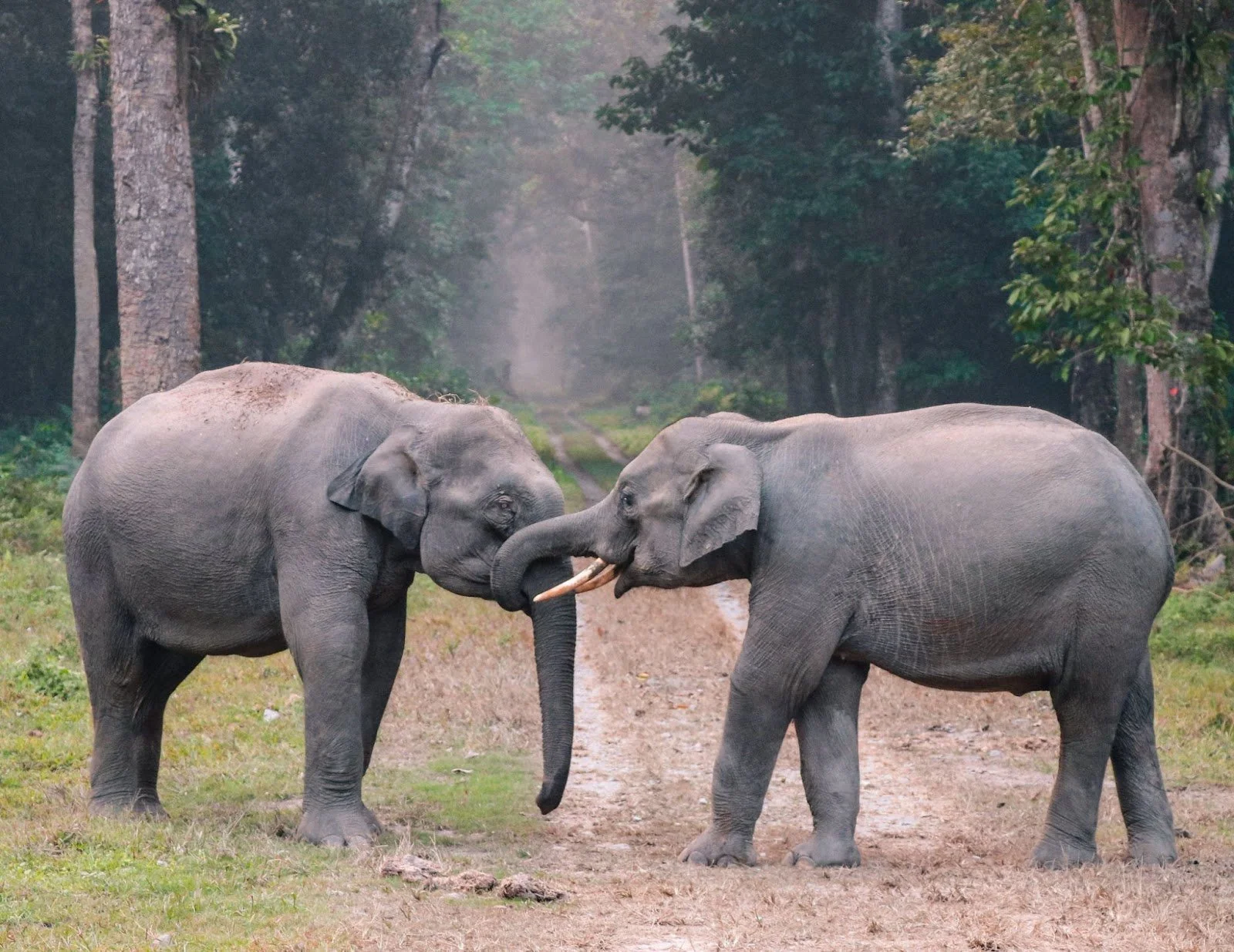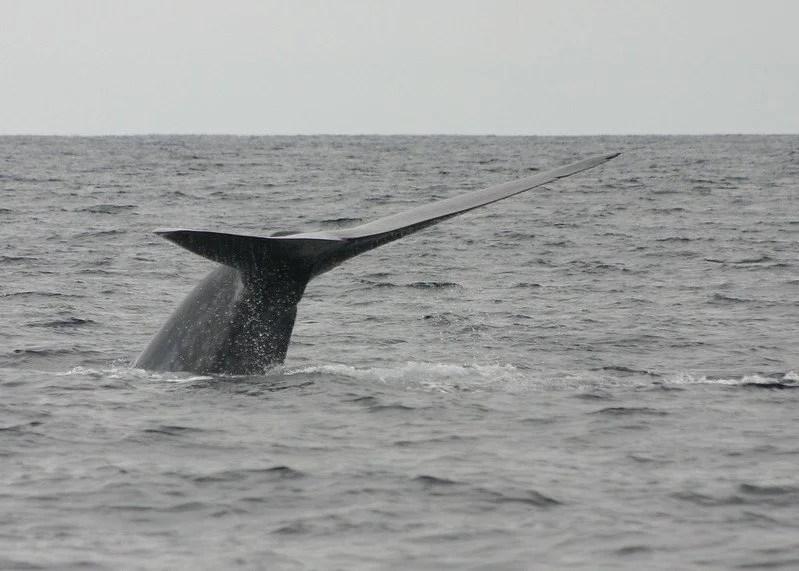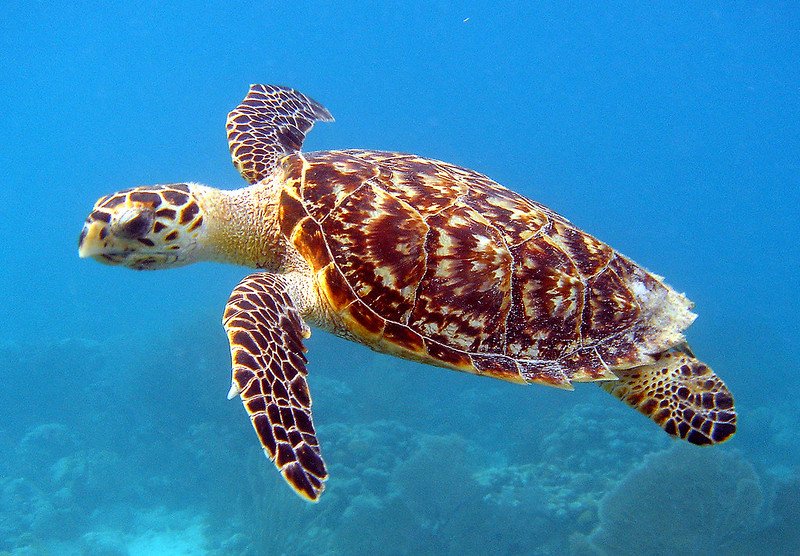The risk of depleting ocean resources and the practice of poaching is driving many vulnerable species to extinction.
Two elephants playing in a forest scene. Future Kiiid. CC0.
A growing number of the planet's animals are teetering on the brink of extinction. These critically endangered species face an uncertain future due to the dire effects of poaching, habitat loss, climate change and other environmental pressures. Wildlife populations of a variety of species have been declining in recent years in a phenomenon known as the Global Extinction Crisis. The risks this entails are a drop in biodiversity as well as decreased resource availability for people. Efforts to combat this trend include the protection of natural habitats, reduced pollution and the enactment of measures to restrict or eliminate overfishing and overhunting.
Blue Whale
Blue Whale Tail Deep Dive. Seabass London. CC by 2.0.
The blue whale, or Balaenoptera musculus, is the largest creature on Earth and a symbol of oceanic grandeur. Despite their colossal size, blue whales are surprisingly vulnerable due to various human-induced factors. Collisions with large vessels and entanglement in fishing gear pose grave risks to their survival. Furthermore, the pervasive issue of climate change has disrupted the availability of their primary prey, krill, as warming oceans alter the distribution of these tiny crustaceans. Efforts such as establishing marine protected areas, restricting boat speed and advocating for sustainable fishing practices are crucial steps to safeguard the future of blue whales.
Black Rhino
Black Rhino in the Savannah. Chris Clark. CC0.
The black rhinoceros, alternately diceros bicornis in scientific Latin, resides in climatically warm eastern and southern Africa in countries like Kenya and Zambia. They are the smaller of the two main African rhino species, the other being the white rhino, but just as threatened. Overall, the species is listed as “critically endangered”, but three subspecies of the rhinoceros, including the western and southern black rhino, have already been declared extinct. By the International Union for Conservation of Nature’s (IUCN) approximation, there are just under 6,500 black rhinos in Africa, a number currently increasing due to conservation efforts.. Despite this, they are threatened by habitat reduction and poaching, the animals long being prized for their famous horns. Between 1960 and 1995, the population suffered severe reduction in its numbers and survival rates because of this brutal practice. Conservation efforts, such as anti-poaching laws, community measures and habitat awareness are critical to preventing the complete disappearance of the black rhino from our planet.
Yangtze Finless Porpoise
Finless Porpoises Swimming. Foooomio. CC by 2.0.
The Yangtze Finless Porpoise (Neophocaena asiaeorientalis) inhabits the Yangtze River in China, and is the only living freshwater porpoise in the world. Members of this species are sleek and snoutless, with no fin on their dorsal ridge, the latter giving them their name. These aquatic creatures have adapted to the turbulent and often complex environment of the river, but they are still struggling; They are primarily threatened by overfishing, pollution, dam construction along the Yangtze and accidental entanglement in fishing nets and equipment. This reduces the population very quickly, so much that there are only between 1,000 and 1,500 viable cetaceans remaining currently. In order to combat the increasing annual decline, China has established finless porpoises as “first level protected species,” the highest level of protection the country offers.
Sumatran Elephant
Sumatran elephant in Tesso Nilo National Park, Indonesia. NonprofitOrgs. CC by 2.0.
The Sumatran Elephant (Elephas maximus sumatranus) is one of three subspecies of Asian elephants, native to the island of Sumatra in Indonesia. They have a smaller build than an African elephant and sometimes possess a curved back. The unfortunate fact about their population in the wild is that it has declined by four fifths 80% in the past three elephant generations. This is due to the illegal poaching for their ivory and their body parts, which further compounds the threats faced by the Sumatran elephant. Also because of deforestation and logging, a large portion of the forest in which they live is too small to contain a significant population. Because of the fragmentation of their habitats, the elephants stray into agricultural areas in search of food, which worsens elephant and human contact. Due to these factors, there are an estimated 2,800 elephants residing on all of Sumatra. Collaborative initiatives pertaining to reforestation and involving both the government and communities would be the best course of action in preserving the Sumatran elephant.
Hawksbill Turtle
Hawksbill Sea Turtle at Carey de Concha. USFWS/Southeast. CC0.
The Hawksbill Turtle, or Eretmochelys imbricata, is mainly found in subtropical/tropical areas of the ocean. It is distinguished by its flatter body shape and beakish sharp mouth. Hawksbill turtles play a huge role in maintaining the health of coral reef systems by controlling sponge populations. Like many iconic creatures, hunting represents the biggest encroachment on the reptile's livelihood, with poachers targeting the turtles for their eggs, skin and shells. Their beautifully patterned shells fetch an unfortunately high price on the black market. In the last 30 years, turtle populations have declined by 80% because of other causes like climate change, plastic pollution, rising sea levels, and accidental capture in fishing gear. Because of these significant factors, there are possibly only 57,000 Hawksbill turtles left.
So how can we help? People can support conservation organizations by volunteering their time to the protection of endangered species. Your involvement or donations can help fund critical conservation projects. People can practice responsible tourism, choosing eco-friendly and ethical wildlife tourism options that do not harm natural habitats. Thirdly, you can advocate for and support initiatives that intend to restore habitats for endangered species, such as reforestation efforts and marine-protected areas. Finally, we can work to make pollution less of a concern by recycling and supporting clean energy to mitigate climate change.
TO GET INVOLVED
Find out more about the World Wildlife Fund, which works to eliminate the worst effects on animals remaining in the world and protect diverse species.
Discover SeeTurtleOrg’s mission, which includes volunteering trips and organizations that dedicate their resources to saving marine life, specifically sea turtles.
Find out about the Defenders of Wildlife, which works to prevent animals and their habitats from becoming vulnerable or imperiled, as well as aims to protect the health of susceptible species.
Riley Baker
Riley Baker is a first-year student at James Madison University majoring in Writing, Rhetoric, and Technical Communication. She enjoys elements of storytelling and creative writing and likes listening to music. In addition, she is interested in journalistic-style writing and editing and intends to focus on writing articles about lesser-known travel locations and impactful world topics.







